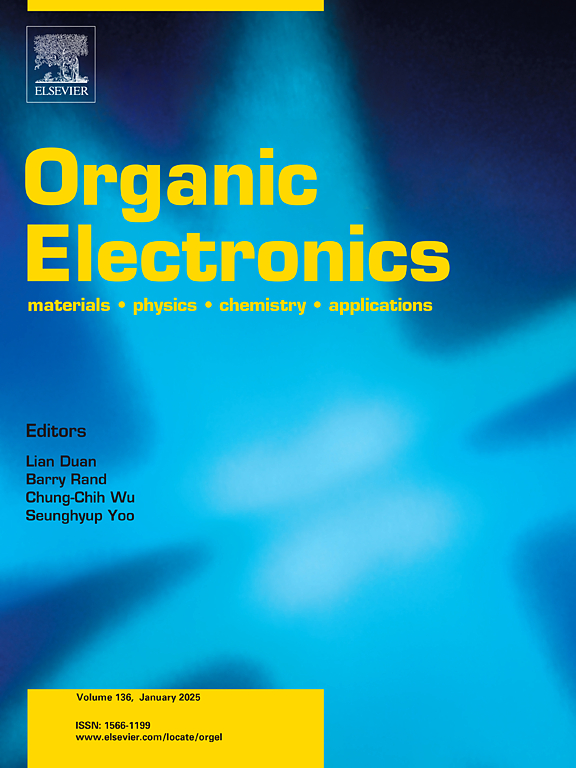用于组织等效剂量测定的多功能有机突触晶体管
IF 2.6
4区 工程技术
Q3 MATERIALS SCIENCE, MULTIDISCIPLINARY
引用次数: 0
摘要
有机突触晶体管(OSTs)遍布现代电子领域,已成为人工智能(AI)系统发展的前沿器件候选者。本文报道了OSTs作为高灵敏度剂量计,也模拟人体组织特性和认知功能。制备的OSTs具有优异的p沟道晶体管特性,场效应迁移率为0.21(±0.03)cm2V−1s−1,在−10 V工作时的通断电流比约为103。OSTs通过脉冲配对促进(PPF)和峰值数依赖的可塑性(SNDP)等行为表现出短期可塑性(STP)。值得注意的是,从PPF行为得出的松弛时间常数,加上每次刺激的能量消耗约10 pJ,与在人类突触中观察到的非常相似。此外,通过对所制备器件的突触权值进行积分,人工神经网络(ANN)的手写数字识别准确率超过99.4%。这些ost在辐照后的电流和迁移率变化可以忽略不计,但阈值电压的变化呈线性变化,适合于检测γ辐射暴露。在与肿瘤治疗相似的辐射量下,对γ辐射暴露具有令人印象深刻的敏感性(~ 5 mV/rad)。我们的研究结果表明,这些柔性ost有潜力被用作智能和智能辐射传感器,用于医疗成像、放射治疗和应急响应人员和武装部队的便携式剂量计等应用。本文章由计算机程序翻译,如有差异,请以英文原文为准。

Multifunctional organic synaptic transistors for tissue-equivalent dosimetry
Pervading the modern electronics landscape, organic synaptic transistors (OSTs) have emerged as a forefront device candidate for advancement in artificial intelligence (AI) systems. This paper reports OSTs as highly sensitive dosimeters which also emulate human tissue properties and cognitive functions. Fabricated OSTs exhibit excellent p-channel transistor characteristics with field-effect mobility of 0.21 (±0.03) cm2V−1s−1 and on-off current ratio on the order of 103 for −10 V operation. The OSTs demonstrate short-term plasticity (STP) through behaviors such as pulse paired facilitation (PPF) and spike number dependent plasticity (SNDP). Notably, the relaxation time constants derived from PPF behavior, combined with an energy consumption per stimuli of ∼10 pJ, closely mimic those observed in human synapses. Moreover, by integrating the synaptic weights derived from the fabricated devices, artificial neural network (ANN) achieves a handwritten digit recognition accuracy exceeding 99.4 %. These OSTs exhibit negligible changes in on current and mobility after being irradiated, but a linearly varying shift in threshold voltage, suitable for detecting γ-radiation exposure. An impressive sensitivity (∼5 mV/rad) to γ-radiation exposure under radiation amount similar to the values used for treatment of tumors. Our results indicate that these flexible OSTs have the potential to be utilized as smart and intelligent radiation sensors for applications such as medical imaging, radiation therapy, and portable dosimeters for emergency responders and armed forces.
求助全文
通过发布文献求助,成功后即可免费获取论文全文。
去求助
来源期刊

Organic Electronics
工程技术-材料科学:综合
CiteScore
6.60
自引率
6.20%
发文量
238
审稿时长
44 days
期刊介绍:
Organic Electronics is a journal whose primary interdisciplinary focus is on materials and phenomena related to organic devices such as light emitting diodes, thin film transistors, photovoltaic cells, sensors, memories, etc.
Papers suitable for publication in this journal cover such topics as photoconductive and electronic properties of organic materials, thin film structures and characterization in the context of organic devices, charge and exciton transport, organic electronic and optoelectronic devices.
 求助内容:
求助内容: 应助结果提醒方式:
应助结果提醒方式:


